Unemployment
recently became an integral part of the active cycle of the
Brazilian workforce’s general trajectory. As a matter of
fact, until the 1980s open unemployment – besides being
residual in the Economically Active Population – was
basically concentrated in the segments traditionally
identified with the most vulnerable groups of the active
population (youth, women, Afro-Brazilians, all generally
with a low level of education).
From
the 1990s on, though, the unemployment rate grew rapidly,
following with the degradation of the general conditions of
work production in Brazil. In that sense, unemployment not
only remains high – about three or four times higher than
rates recorded in the 1970s and 1980s – but also radically
changed the nature of its presence inside the workforce.
As
there are no longer any social segments that are immune to
the risk of unemployment, it is expanding beyond traditional
groups that are vulnerable within the workforce.
Paradoxically, as a country that still has low levels of
education among the population, Brazil started facing the
fastest expansion of unemployment in the most educated
segment of the Economically Active Population, thus feeding
the anomaly of the brain drain phenomenon: in short, the
emigration of the population with the highest education and
professional qualification.
Thus,
part of the efforts that families and individuals make to
improve the quality of the workforce supply ends up
internally despised, causing intellectual unemployment and
the export of qualified workers to other nations that may
adequately incorporate them.
In
this context, the involuntary idleness of the workforce
manifested itself in new ways over the last two decades. On
one hand, traditional unemployment is associated with the
level of general economic activity, and thus reaches almost
two-thirds of the total jobless workers in the country; on
the other, structural unemployment acquires a growing
dimension, marked by the longevity of the idleness of the
workforce associated with the country’s model of insertion
in the global economy. In short, one notes that periodical
unemployment may be easily reverted by increasing the rate
of productive activities, while structural unemployment
requires important changes within the standard relationship
to globalization.
Currently,
structural unemployment presents three distinct forms in
Brazil. The first is repetitive
unemployment, usually concentrated in youth, and related
to growing difficulties in transitioning from the school
system to the job market. Obstacles to career-building for
some age segments of the active population lead to
occupational instability and recurrent unemployment.
The
second form is conversion
unemployment, usually associated with older segments of
the population (25 to 45). Even with higher education, the
worker who faces a break in his career because of
unemployment tends to show more difficulty in returning to
an equivalent labor situation, with the probability of
structurally going back to unemployment, be it because of
changes in the production organization and work management,
or because of increasing competition within the job market.
Lastly,
the third form is exclusion
unemployment, strongly associated with the profile of
people over 40 years of age. Once a previous contract-
generally a wage contract- is interrupted, the worker finds
almost insurmountable obstacles to land a job that is
compatible with his or her previous experience, even if s/he
has better education. Age prejudice becomes relevant in
hiring decisions.[1]
In
this framework, it is imperative to recognize the more
complex significance in Brazil of the relationship between
education level, economic development and involuntary
idleness of the workforce. In a way, structural unemployment
is associated with two different sets of problems, which end
up converging. The first relates to the economic sphere
(macro and micro). In macroeconomic terms, the quantity and
composition of unemployment in a given country are connected
not only to the rate of national economic expansion but also
to the model of insertion in the global economy.
As
long as the rate of economic growth remains low, Brazil
tends to specialize in the production and marketing of low
value-added goods, with limited technology content and
dependent on the low cost of labor. In this sense, economic
growth may demand more workers, but the profile of employed
workers tends to be associated with low compensation and
precarious work conditions, not always accessible to highly
educated and professionally qualified workers (repetitive
and exclusive unemployment).
In
microeconomic terms, the educational level and situation of
the unemployed is related to the companies’ functional and
organizational structure, especially when there is a
disconnect between new forms of production and job
organization. Within existing chains of production in Brazil,
it seems that a system of wild competition and spurious
outsourcing of labor is favored over a regime of functional
and organizational cooperation, which turns the quest for
higher productivity into a result of degrading work
conditions and not of a synergic increase of investments (repetitive
and conversion unemployment).
The
second set of problems is related to the sphere of education.
In a developing country, it is a paradox to produce
knowledge while increasing the professional qualifications
of workers, who often end up working in rich countries.
This
happens because productive activities in the country do not
fully utilize the results of investments in science and
technology to their advantage. More often there is a clear
separation between the worlds of knowledge and production.
However, these are consolidating, as there is a
growing interest in buying technology abroad instead of
fostering local generation.
For
these reasons, the prevalent misalignment between economic
and educational spheres tends to indicate a continuity of
structural unemployment in Brazil.[2]
Its main characteristics will be considered below.
Structural
Unemployment in Brazil
Structural
unemployment in Brazil may be analyzed from two
perspectives. The first one relates to the significant
quantity of involuntarily idle labor since 1990, while the
second refers to changes in the profile of those unemployed,
no longer concentrated – almost exclusively – within the
so-called vulnerable segments of the population. The
situation of mass unemployment and the anomaly of
intellectual unemployment and the brain drain will be
briefly presented below.
Mass
unemployment
Brazil
already currently suffers from a grave lack of stability as
seen in the high national open unemployment rate, as
measured through the parameters of the Pesquisa
Nacional por Amostra de Domicílios.*
The
current rate of national unemployment is practically 40%
above that of 1995, when Brazil reached monetary stability.
Before that, the national open unemployment rate in Brazil
was 2.4 times less than in the 1980s and 3.8 times less than
the second half of the 1970s.
In
the last two decades, not only did the national open
unemployment rate grow dramatically in the country, but the
number of involuntarily idle workers did as well. In 2005,
for instance, Brazil recorded a contingent of 8.9 million
workers who could not find a job, not even for an hour,
during the period in which IBGE’s**
national research was performed.
Graph
1
Brazil
– Open Unemployment Rate Evolution
(%
of Economically Active Population)
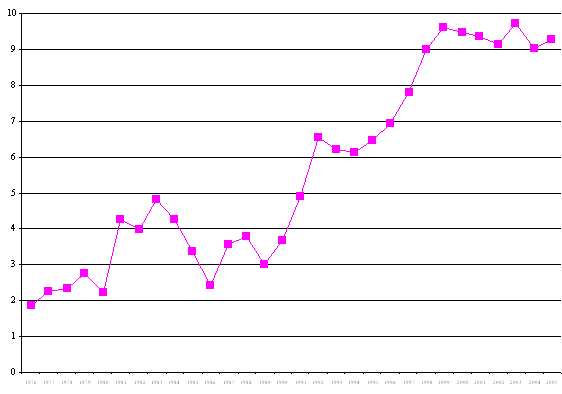
Source:
IBGE/PNAD’s data adjusted by the author
A
comparison with 1995, when monetary stability began in the
country, shows that there was a contingent of 4.4 million
fewer unemployed people. In 1989, previous to the beginning
of the experiment with neoliberal policies, the unemployed
contingent was 6.9 million fewer than in 2005.
Graph
2
Brazil
– Evolution of the Number of Unemployed
(in
thousands)
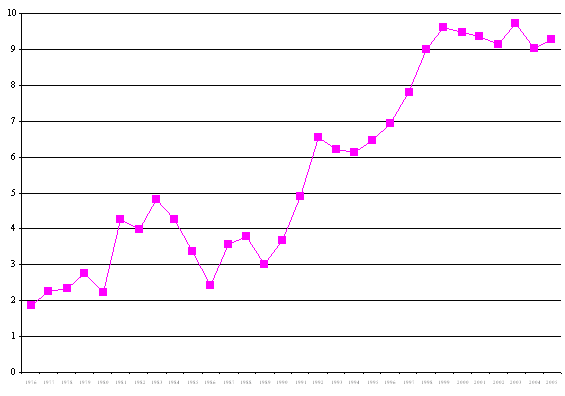
Source:
IBGE/PNAD’s data adjusted by the author
Finally,
a comparison with the final year of the cycle of national
industrialization (1980), when the average economic growth
was around 7% per year, the total number of unemployment was
7.9 million fewer than in 2005. Undeniably, the presence of
low economic growth in the country, paired with neoliberal
policies and the passive and subordinated insertion of
Brazil in the global economy, constituted a new context of
massive and structural unemployment.
In
spite of the absolute and relative gravity of unemployment
– with no parallel in any other Republican period –
there is a notable change in the profile of the unemployed
in the country. Although there is no labor segment immune to
involuntary idleness, it is clear that some social groups
tend to make up a larger portion of unemployment.
Intellectual
Unemployment Anomaly
Opposing
global trends that require longer schooling and higher
professional qualification, as a component of a set of
necessary requirements to reduce the risk of unemployment,
Brazil keeps generating an increased rate of workforce
idleness precisely in the population that has more years of
schooling. On one hand, there is an important increase of
the number of years at school in practically all age groups
in the population.
In
2004, for instance, the Brazilian population had an average
6.6 years of schooling, while in 1993 the average was just
5.1, i.e., an increase of almost 30% in the number of years
of schooling for the entire
Brazilian population.
Graph
3
Brazil
– Evolution of Average Years of
Schooling
– 1993 and 2004
(10 years or more
of age)
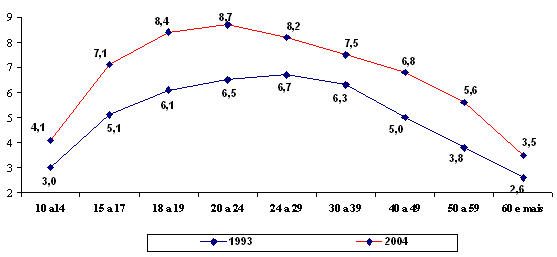
Source:
IBGE/PNAD’s data adjusted by the author
On
the other hand, one notes that, in spite of the effort to
increase schooling for the entire population during the last
decade, unemployment grew dramatically for the segment with
higher education. In 2004, for instance, 60.2% of unemployed
(8.3 million workers) had graduated from high school, while
in 1995 only 37.7% of all unemployed (4.5 million) had up to
eight years of schooling.
In
the case of those unemployed that had a college degree,
their numbers tripled in the same period (98,000 in 1995 and
247,000 in 2004). In 2004, there were 1.7 illiterate and
unemployed people for each unemployed person with 15 or more
years of schooling, while in 1992 illiterate people counted
for 3.6 to each unemployed person with a college degree.
Graph
4
Brazil
– Variation in the Number of Unemployed by Years of Study)
between 1995 and 2004
(in
%)
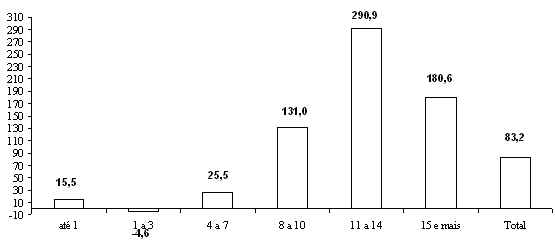
Source:
IBGE/PNAD’s data adjusted by the author
For
an increase of 83.2% in the number of unemployed people
between 1995 and 2004, the increase of illiterate unemployed
was only 15.5%, while for those with the least number of
years of schooling (1 to 3 years) there was a decrease in
the total number of unemployed. Because of that, the
national economy is characterized by the anomaly of an
intellectual unemployment larger than the unemployment of workers
with low education.
Graph
5
Brazil
– Relationship between Unemployment Rate and Education
Level in Selected Years
(in
%)
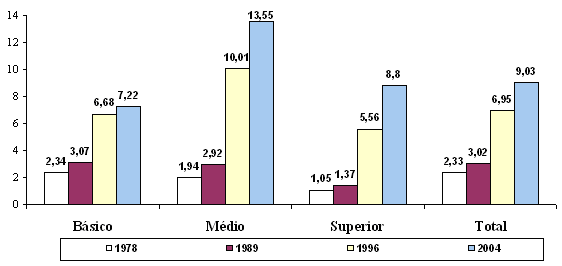
Source:
IBGE/PNAD’s data adjusted by the author
In
the 1970s and 1980s in Brazil, a higher education guaranteed
a lower risk of unemployment. For the workforce segment with
12 or more years of studies, for instance, the national
unemployment rate was 44.6% less than the one for workers
with up to eight years of schooling.
In
2004, the national unemployment rate of the segment of the
Economically Active Population with higher education
exceeded the rate for workers with a lesser number of years
of study. Because of this, the relationship between the
national unemployment rate for the segment with schooling
equivalent to Ensino
Básico
and
the national unemployment rate for the segment with
schooling equivalent to Ensino
Médio
e Superior*
started decreasing from the 1990s on.
Graph
6
Brazil
– Relationship between Unemployment
Rate and Education Level in Selected Years
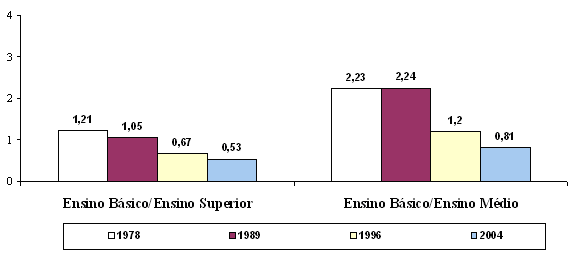
Source:
IBGE/PNAD’s data adjusted by the author
Thus,
in 2004 the national unemployment rate for the segment of
the Economically Active Population with an education level
equivalent to Ensino Básico was almost half of the
workforce with schooling equivalent to Ensino Médio.
Fifteen years before (1989), the relationship was
practically equivalent between the unemployment rates among
workers of Ensino Básico and Médio.
The
same change is noted in the relationship between the
unemployment rates for workers with Ensino Básico and
Superior. In that sense, structural unemployment tends to
converge toward those workers who are better educated.
This situation, however, is an anomaly specific to Brazil in
the last two decades. According to international experience,
mainly regarding developing countries that contemplate
increasing investment in new technologies, unemployment
converges inexorably to workforce segments with the least
education.
In Germany, for instance, the unemployment rate of the
workforce with schooling equivalent to Ensino Básico grew
3.3 times in the last two decades, while the unemployment
rate of the EAP with college or university grew 2.6 times,
according to OCDE (Employment Outlook, various years).
Also in the United States there was
a smaller growth of unemployment for the workforce
segment with higher education (the unemployment rate grew
2.3 times for workers with middle school education,
and 1.9 for workers with college or university education).
Graph
7
Relationship
between Unemployment Rate and Education Level in Selected
Countries, 2000
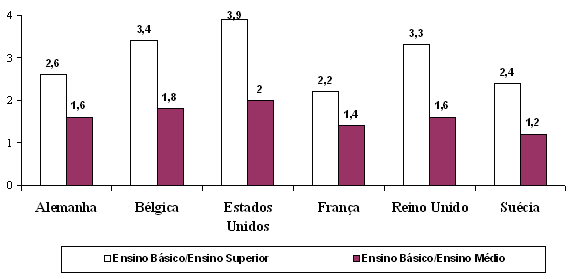
Source:
OCDE, 2001
Because
of that, the relationship between the unemployment rate for
the workforce with Ensino Básico and that with Ensino Médio
e Superior increased. In the United States, for instance,
the unemployment rate for workers with basic education was
almost four times as high as the rate verified for workers
with college or university education, while the workforce
segment with basic education showed an unemployment rate
twice as large as that for the workforce segment with middle
school education.
Brain
Drain
In
Brazil, the phenomenon of brain emigration toward rich
countries became notable in the last two decades. With no
prospect for decent jobs and an improved life, a portion of
the youth ends up pressuring the Department of Immigration
in developed countries, in search of decent work and a
better quality of life.
The unfavorable situation in the job market for those who
have higher education in Brazil helps us to understand the
motives that especially drive young people to go abroad in
search of what they cannot abundantly find here. In 2004,
for instance, the average salary of a college level worker
was 1.5 times higher than the average salary of the
elementary school level worker. In 1995, it was two
thirds higher.
What’s
more, it is also notable that the unemployment rate
increased much more for those with higher education. In
2004, for instance, the unemployment rate for workers with a
college degree was more than 25% above that of 1995,
slightly above the increase of the unemployment rate for
workers with elementary school education.
Graph
8
Brazil – Evolution of Work
Compensation and Unemployment Rate by Years of Schooling
between
1995 and 2004
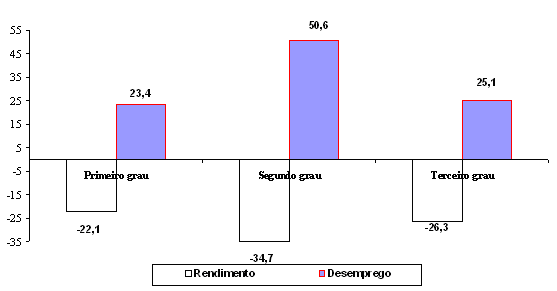
Source:
IBGE/PNAD’s data adjusted by the author
There
is undeniably something bizarre going on in Brazil. How can
we comprehend a better education without a better salary, in
real terms, and lower unemployment?
It
so happens that education, although fundamental to being
able to compete in the job market, is not enough, by itself,
to assure a decent job and a dignified salary. Other
variables are at stake, such as the rate of economic growth
and the way Brazil is inserted in the global economy.
In
a country with continental dimensions such as Brazil, where
more than 2.3 million people enter the job market annually,
it is necessary that the national economy grow at least 5%
per annum just to absorb all the human population. Without
it, competition in the job market, even for simple positions,
ends up leading to salary reduction and mass unemployment.
The
type of economic
growth must also be considered, as there is a kind that
implies the production of services and goods of low unit
value and little technology content, generating job
positions that require a low cost of labor. But there is
also economic growth associated with the production of high
value-added goods and services, high technology content, and
is intensive in well remunerated jobs.
In
a country of low schooling (below seven years of schooling),
the emigration of the segment of the population precisely
with higher education is an enormous contradiction, as it
implies the failure of national efforts to promote education.
According to the census (IBGE) in the period 1991-2000, the
balance between immigration and emigration was negative, as
more than 1.3 million Brazilian youth left the
country.
Graph
9
Brazil – Evolution in
the Number of Students Abroad between 2003 and 2006
(in
thousands)
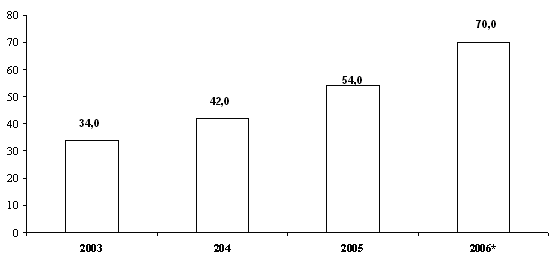
Source:
BELTA
In
the first half of the first decade of the twenty-first
century, it is estimated that between 140,000 and 160,000
Brazilians emigrate each year. In the year 2006 alone,
estimates indicate that around 70,000 Brazilians left the
country to study abroad, especially in countries like the
United States, Canada, the United Kingdom, Australia, New
Zealand, and Spain, among others.
For
a nation born basically out of immigration, Brazil is
already becoming, at the beginning of the twentieth-first
century, a nation of emigrants, shown by a negative balance
between entrance and exit of residents. It is not a matter
of containing or depressing the production and export of
primary goods, nor of containing the advancement of studies
abroad.
But
it appears fundamental for the country to invest in sectors
committed to the production of high value-added goods and
services, increasing technology content, as well as
articulating with their job market the departure and return
of young Brazilian students. Thus Brazil will be able to
alter the profile of its passive and subordinate insertion
in the global economy, and then compete for strategic
markets such as new materials, biotechnology, chemistry, and
microelectronics, among others. However, this requires
another macroeconomic policy, one that can break the current
cycle of the “financialization” of wealth, which only
blocks the perspective of inclusion through decent work.